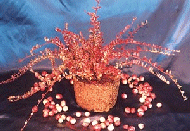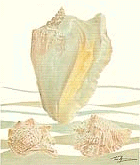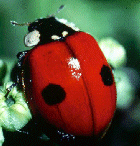|
REUs Galore!
We primed the pump with our recent
Howard Hughes Grant. Next,
federal agencies, including the National Science Foundation, changed their
focus toward a greater emphasis on undergraduate education. Now,
Research Experiences for Undergraduates
(REUs) are becoming a regular feature of undergraduate
education. The incorporation of more hands-on experience in the curriculum
is in response to assertions that undergraduates who participate in research
do better in
future endeavors. What is your opinion of this change?
Here at UMass the REUs are administered by the Biology Graduate Programs; we
have a Plant Biology REU, a Neuroscience REU, and a BioTechnology REU.
A model for the administration of REUs was developed during our original Howard
Hughes-funded REU (1996-2000). That model is being replicated and
elaborated by the new REUs.
In a typical REU experience, undergraduate participants work in a faculty
member's lab for a summer or semester.
The student carries out a research project and periodically meets with other
members of the REU group to discuss the experience. Several presentations
by the student are included. The first deals with the research project
that is planned, the next presentation focuses on work that is being done,
and the last deals with what has been accomplished.
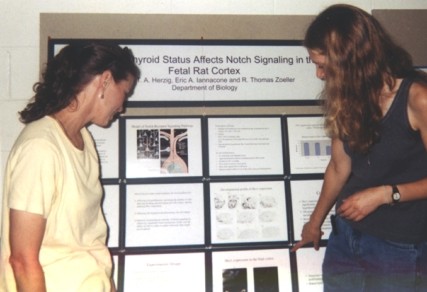 On the right, undergraduate Carolyn Herzig explains her project poster
to another undergraduate at a BioTech REU symposium held during the summer of 2000.
The REU experience will either confirm a student's enthusiasm about
a discipline or convince him/her to look for a another career.
On the right, undergraduate Carolyn Herzig explains her project poster
to another undergraduate at a BioTech REU symposium held during the summer of 2000.
The REU experience will either confirm a student's enthusiasm about
a discipline or convince him/her to look for a another career.
Many students must work during the summer or a school semester.
The REUs provide stipends and thus obviate semester and summer jobs.
As an additional way of removing barriers to participation, travel expenses to
and from a home location are also covered.
When we were first awarded the
Howard Hughes grant, the University made a commitment to find ways to support
future REU programs through local funding. Currently, the BioTechnology
REU is being funded cooperatively with BayState Medical Center, which sees
the involvement of undergraduates in laboratory research as an important way
of nurturing potential health science workers.
|
Darwin's Finches Sing a Song about Food
The classical example of evolutionary diversification, Darwin's finches, is
in the news again. Jeff Podos, our new behavioral ecologist, has
just published evidence in the journal Nature in which he identifies
a possible cause for
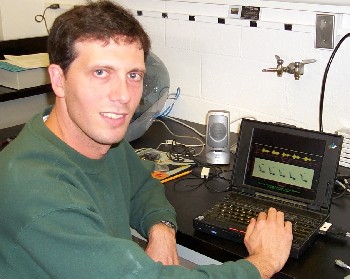 the rapid evolution of both vocalization and species diversity in Darwin's finches.
Jeff was awarded an NSF grant to study these phenomena. He is taking
annual field trips to the Galapagos to gather data to test his theories.
the rapid evolution of both vocalization and species diversity in Darwin's finches.
Jeff was awarded an NSF grant to study these phenomena. He is taking
annual field trips to the Galapagos to gather data to test his theories.
Jeff's research equipment includes audio and video recorders which allow him to
simultaneously capture the vocalizations and behavior of his target
species. To test his hypotheses, Jeff analyzes behavior, beak morphology,
and vocalizations. Experiments include the playing of high quality male
vocalizations to a female to see how she responds.
The audio recordings of bird song are transformed into sonograms which are plots
of time, frequency, and intensity of songs. The remarkable finding is
that,
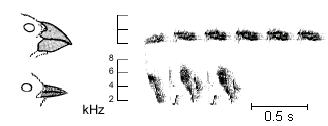 in eight species of Darwin's finches, certain aspects of vocalization are
related to variation in beak structure (see sonograms at right for Geospiza
fortis (upper) and Certhidea olivacea (lower) abstracted from his
Nature illustration).
Food availability could be a driving force for changes in beak structure which
might lead to behavioral isolation via mating incompatibilities.
Thus, two powerful interacting forces, feeding and communication at the time
of mating, could be the causative agents of rapid speciation.
in eight species of Darwin's finches, certain aspects of vocalization are
related to variation in beak structure (see sonograms at right for Geospiza
fortis (upper) and Certhidea olivacea (lower) abstracted from his
Nature illustration).
Food availability could be a driving force for changes in beak structure which
might lead to behavioral isolation via mating incompatibilities.
Thus, two powerful interacting forces, feeding and communication at the time
of mating, could be the causative agents of rapid speciation.
Furthermore, in a number of species of Darwin's finches, beak structure has
been shown to vary from generation to generation, depending on the types of
available food.
This adds credence to Podos' theories of interplay between beak shape and
communication. Could the changes in food types over protracted time
intervals result in the selection of beak shapes that preclude vocalizations
once successful in attracting mates? This might select for species with
a more variable song repertoire.
In Jeff's hands, Darwin's finches have once again become a laboratory
for the study of evolution.
|
 Chairman Chairman
Woodcock's
Corner
Biology continues to be one of the most popular majors at UMass with over 800
at last count, and our department continues to hum with activity. One of
the bigger changes that has been happening in recent years is the increasing
number of faculty retirees. As a consequence of the
|
dramatic expansion of the University in the 60's, almost half of the UMass faculty will reach
retirement age in the next decade. In Biology, we have already felt the
impact of the wave of retirements (12 in the last 10 years), and this year we
will be saying farewell to Stuart Ludlam, David Mulcahy, and Bernard Rubinstein. As you will read on p4, retirement is often the beginning
of a new career phase for faculty as Emeritus Professors,
|
and right now, 7 Emeriti (Ed Davis, Arthur Mange, Jack Palmer, Hal Rauch,
Ted Sargent, Art Stern, Bob Wilce), have
office or lab space in the Department. Retirements also provide an
opportunity for us to recruit new teachers and researchers, and this year we
have been searching for new faculty in Vertebrate Evolution (see p4) and Cell
Biology. Students seem to be especially attracted to work with new
faculty (minimal generation gap?), and the fresh ideas they bring
|
to their teaching has a very positive impact throughout the department
(see p2).
As we look to the future, further changes are in store, one of which will be
'Distance Learning'. How does a department that emphasizes hands-on
experience in teaching and research labs take maximal advantage of this
opportunity? We would very much like to hear your opinion on this and
other aspects of department life - by e-mail, 'snail' mail or any other conduit.
CLFW
|
